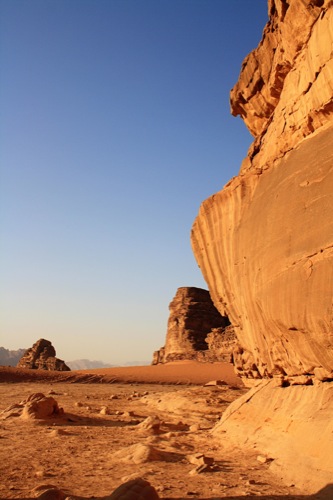
Wadi Rum
I took a moment to catch my breath. The gigantic sand dune kept going straight up into the air while down below me, people were already looking like Polly Pocket dolls.
But it was the challenge of the Wadi Rum desert that kept me climbing. Each footstep left a mark in the warm sand as I continued barefoot up the steep, slightly shifting staircase to the blue sky above.
When I finally reached the sand dune’s peak, I gasped. It seemed the entire expanse of the Wadi Rum desert was laid out before me, with my tiny group below the only sign of human life. When I called out a hello, the sound returned to me several times over in a vibrating echo across towering rock cliffs and flat sands.
“Even if you are magnificent, Wadi Rum makes you feel insignificant,” said Kamel Jayousi, tour guide for the Jordanian Tourism Board. “T.E. Lawrence loved Wadi Rum. He called it vast, echoing and godlike. They shot much of the movie ‘Lawrence of Arabia’ here.”
I never knew that desert landscape could be so breathtakingly beautiful until my journey through Jordan last September. Jordan’s natural, historic and religious wonders made my trip to this small country an unforgettable adventure.
Hercules in Jordan
You might not think of Hercules when you think of Jordan. However, Hercules — at least a statue of him —looked over Jordan’s capital of Amman on Citadel Hill during Roman times.
Although all that is left of the once giant statue is little more than a piece of the hand and columns from the former temple, it is enough to imagine the statue’s former grandeur.
Walking through the Citadel’s Stone Age, Roman, Byzantine and Muslim ruins, I became fascinated by both the history and the sweeping view of Amman’s busy streets and limestone buildings covering the surrounding hills.
“Inhabitants were at this site as early as 4,000 B.C.,” said Jayousi. “It’s been occupied almost nonstop since then because everyone wanted this easily defendable location.”
Although Jordan’s history reaches back centuries, it is a relatively young country dating back to the 1940s. A stable government and peaceful relations with surrounding countries has enabled it to welcome millions of tourists each year.
“Jordan is like a quiet house in a noisy neighborhood,” said Jayousi. “People see the Middle East as one package, but Jordan is a peaceful country. The stability of Jordan helps the entire Middle East.”
That evening I listened to the melodious Islamic call to prayer at Wild Jordan. Run by the Royal Society for the Conservation of Nature, the restaurant serves mostly organic and local fare from Jordan. As I enjoyed my Jordanian meal, I gazed out at the sunset view of Amman until only the lights of the city remained.
The following day, we saw the large triumphal stone arch that marked the entrance to the ancient Roman town of Jerash. The Roman emperor Hadrian constructed the imposing arch to commemorate his visit there in A.D. 129. The archaeological site is considered one of the best-preserved Roman provincial towns, with some of the ruins reconstructed and some original from the second century.
“There are columns here that have been standing since they were put up at the site,” said Jayousi. “When you put your finger on it, you can feel it move because it was built to sway with the wind. That’s why the columns have lasted so long.”
At the expansive site, I wandered past the 3,000-seat Roman theater, the Temple of Zeus, the Temple of Artemis, Main Street, Oval Plaza and the giant hippodrome used for chariot races. The chariot area has been partially restored, so it was easy to picture someone like Ben-Hur racing around the arena.









